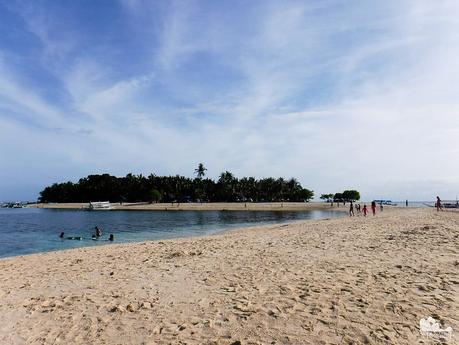
One of the nice things about traveling is that when you least expect it, there’s always a silver lining that shines through the clouds. That has happened to us before in Roxas City where we were stranded prior to our epic Mt. Guiting-guiting climb. During this pre-summer trip, it happened again, albeit in a different way! What followed a disappointing Cuatro Islas island hopping tour was an amazingly fun overnight stay in Digyo Island thanks to a great company of friends.
We arrived at Digyo Island way before our projected schedule due to unscrupulous boatmen who wanted to expedite our island hopping tour. Nevertheless, we started looking for a good place where we can set up camp. We pitched our tents in a coconut grove at a less visited area in the island. We chose this area not just for its solitude but also because it was next to a hut where the island’s policemen are stationed.
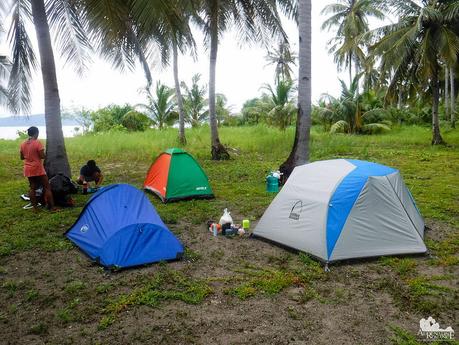
Enterprising locals, most probably from the mainland, regularly visit the island to sell some stuff. Their presence is definitely welcome for most beachgoers. They sell snacks, cold beverages, coffees, and other items you usually find in sari-sari stores.
See those big blue containers? Those contain fresh water for washing and bathing. They cost around P 40 per container. We bought four of those containers to last for the entire weekend.
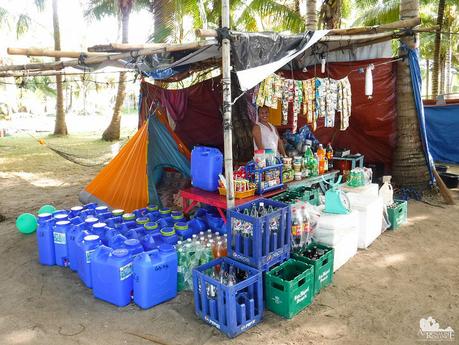
Local fishermen frequently stop by Digyo Island; we believe this was a rest stop for them in the past. Thus, they bring a lot of fresh bounties from the sea. Fish, squid, sea urchins—you name it. We bought a large fish for lunch and had the locals grill it for us.
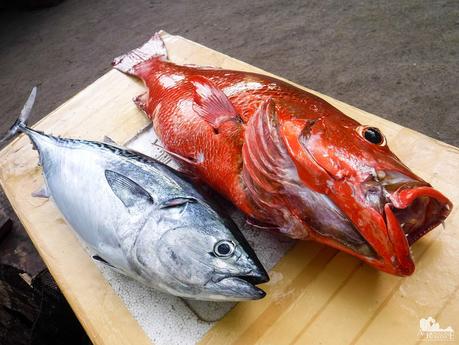
After an hour, a young guy walked to our campsite. Smiling widely, he presented a tray of pefectly grilled fish. Mmmmmm!
We also prepared salted egg salad (sliced salted egg mixed with minced tomatoes, onions, and spring onions) and served chopped grilled chicken that we bought at the mainland.
See those luscious brownies? Those are our celebration cakes. This sojourn is also a way to celebrate Ferna’s birthday.
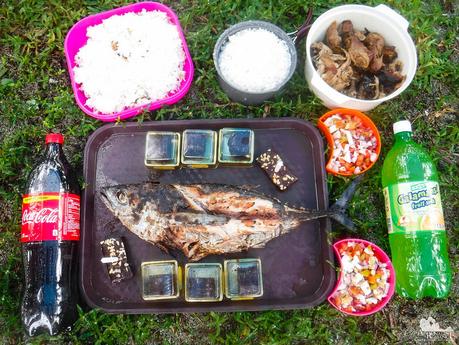
After a filling lunch, it was time to explore the island and have some fun. The centerpiece of Digyo Island is this huge, ancient Balete tree. How was it able to survive the constant onslaught of unfertile soil, salty see breeze, and blazing sunlight?
Due to their strange, viney forms, balete trees are often regarded as dwelling places for mysterious supernatural beings. In fact, in some cultures, locals perform sorcery rituals beside or inside the hollow chambers of large balete trees.
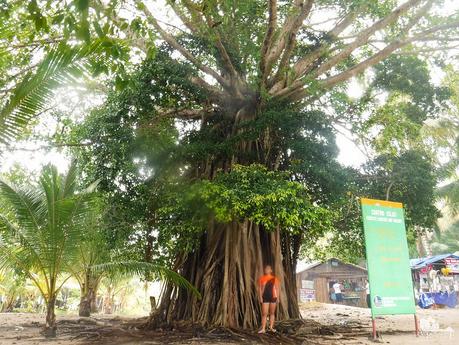
The main campsite at the eastern end of the island is grassy and filled with beachgoers. Coconut trees provide much needed shade against the blazing sun. Many people choose to camp here because it’s nearer to the stores and Digyo’s main feature—a gorgeous sandbar.
But you know us—we want solitude. Thus, we camped at the western end of the island where there were fewer people.
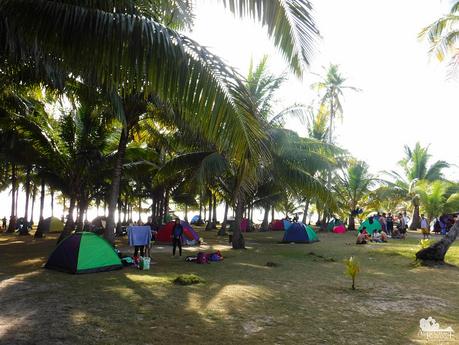
Digyo Island’s sandbar is its major attraction. Surrounded by shallow water on both sides, the sandbar is a favorite place for visitors. The shallow water also makes the sandbar safe for non-swimmers.
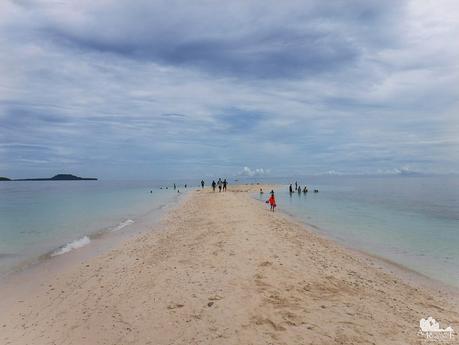
We can’t resist the aquamarine water, so we simply plunged in. One nice thing about swimming during rainy weather is that the water becomes comfortably warm. And have you ever taken a hot bath or shower? It feels so good!

As the day wore on, more and more people flocked over the sandbar. We left the sandbar and decided to walk around the entire island until we circle back to our campsite. We were careful not to walk too close to those palm-like plants. They have razor-sharp leaves that can painfully cut through your skin if you’re not careful.
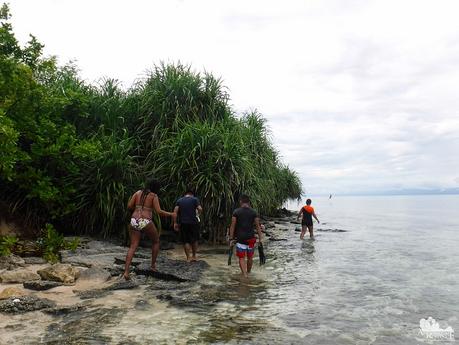
The northern side of the island is barely visited, and we saw why. There’s no sandy beach here; the shore is made up of slabs of rock which most beachgoers find unappealing. But for us, the absence of a nice stretch of sand is a unique characteristics. These rough slabs harbor an immense quantity of marine lifeforms such as crabs, mollusks, clams, and small fish.
Just be careful if you wish to swim here, especially during bad weather. Strong waves and currents can carry you towards those sharp rocks. Ouch!
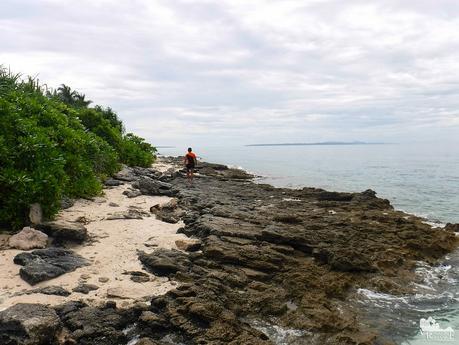
Marine Sanctuary
It was a good thing that we bought our masks, snorkels, and fins because we found out that Digyo Island has its own marine sanctuary. Happily, we swam a few hundred feet away from shore so we can check out healthy corals and awesome marine life.
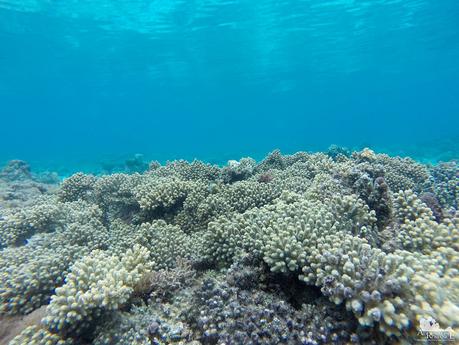
The sanctuary sits on top of a vast sand bed filled with eelgrass. Therefore, the corals are not formed like a cohesive reef. Rather, hard and soft corals are scattered over in splotches all over the place.
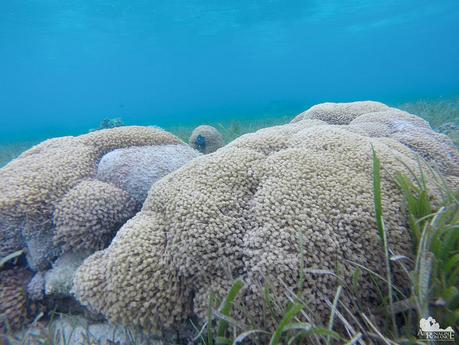
Yellow sponges! Until the introduction of synthetic sponges, natural sponges like these were once harvested to be used as padding, utensil cleaning tools, paint applicators, and more.
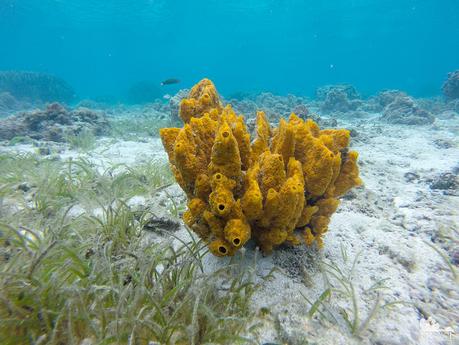
Digyo Island’s marine sanctuary is home to a lot of small reef fish. In fact, we saw dozens of domino and orangetail blue damselfish swimming close to their coral homes, eyeing us warily.
The presence of many reef fish means that bigger fish that eat them frequently visit here. Unfortunately, we didn’t find any large fish due to an annoying jetski that kept speeding above the sanctuary. The jetski driver was utterly oblivious that there were swimmers and divers in the sanctuary. We hope Inopacan government officials would establish areas where watercraft can safely ply without endangering swimmers.
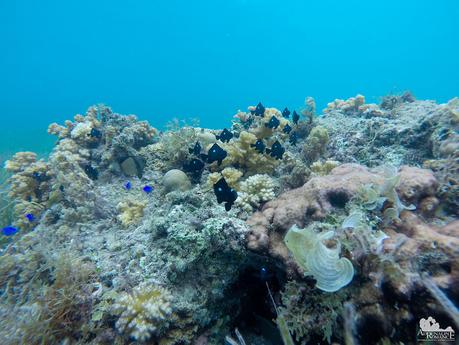
Overcome by curiosity, an anemone fish left its protective anemone home and swam up to me for a closer look. Check out those healthy hard corals.
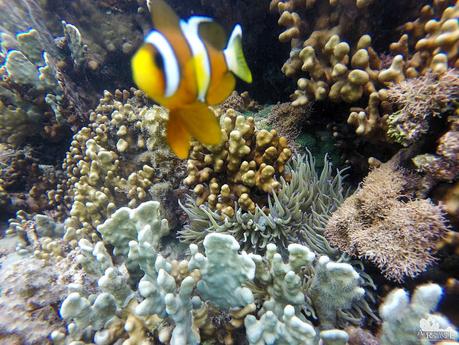
The jetski driver gradually zipped closer to the shore and well within the marine sanctuary. Fearing for our safety, we swam back to the beach. On our way, we spotted this bullseye puffer fish cautiously tailing us. If the pufferfish feels threatened, it can rapidly expand their elastic stomach by gulping in air or water. Instead of a tasty fish, a potential predator suddenly finds itself face to face with a large ball of spikes.
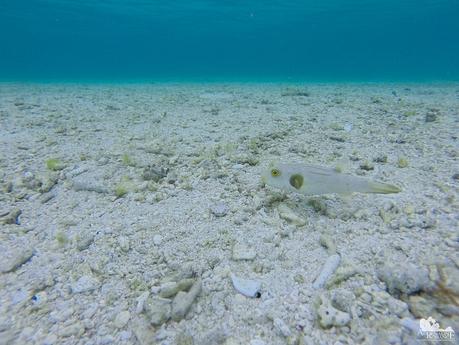
As the tide receded, moss-covered rocks were left uncovered. Moss has been used all over the world for a variety of purposes. North American tribes, for example, use them as bedding. Citizens in Nordic countries stuff moss between logs in log cabins for insulation. People in the Pacific Northwest line their food storage baskets with dried moss. Underestimate these seemingly ubiquitous plants at your own peril.
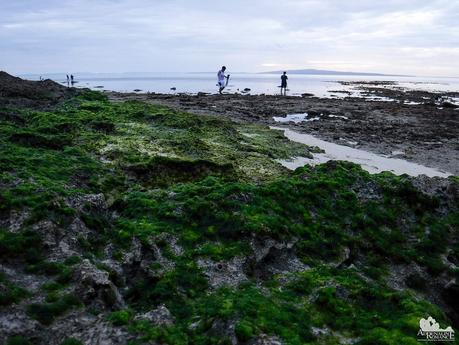
Even though the day was mostly overcast, a slight sliver of the setting sun still broke through the gray clouds. Painting the seascape with a multiple shades of purple and orange, the sunset was absolutely beautiful.
Reestablish your connection with Mother Nature by putting your gadgets aside for a while and simply enjoy that magical moment when the sun says goodbye to the day.
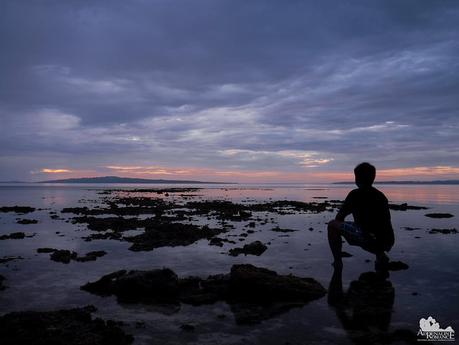
Everyone took a quick fresh-water bath before enjoying a filling pasta dinner. John, Alexa, and I crawled into the tent; the waves of sleep catching up to us quickly. But for Ferna, Lai, and Sweetie, it was time for a card game underneath the stars.
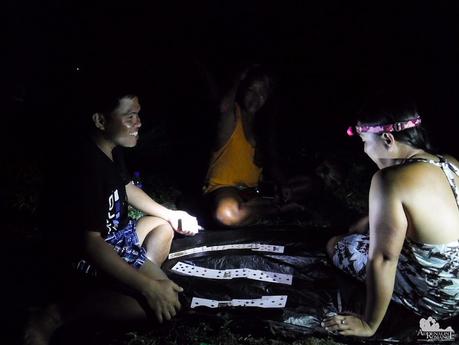
The lullaby of the sea serenaded us to sleep so completely that we missed sunrise. The bright sun was already above the horizon when we stretched out our limbs. To energize for the day’s adventure, we gobbled a large breakfast of sausages, scrambled eggs, noodles, and leftover fish.
Check out our camp. We were totally isolated from the weekend mob.
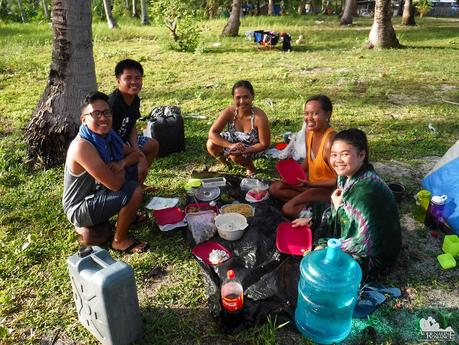
Our boat was bound to arrive a few hours later, so we had some a lot of time to go around Digyo Island. The main southwest beach is especially gorgeous. The whole stretch consists of fine white sand that is almost as fine as talcum powder.

For people who have no tents or do not wish to set up a picnic mat, they can rent out these open-air cottages.
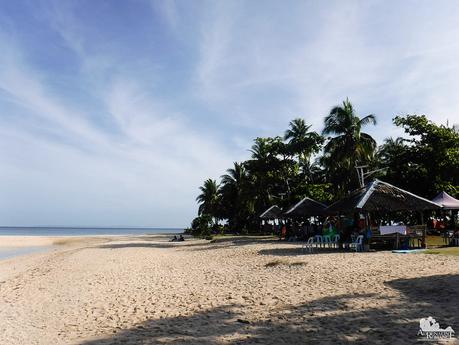
A small sandbar bulges out in front of our campsite. If you want to stay away from massive throngs of people in Digyo Island, this is one of the nicest place to swim in. Also, the marine sanctuary where we swam in lay just beside this sandbar.
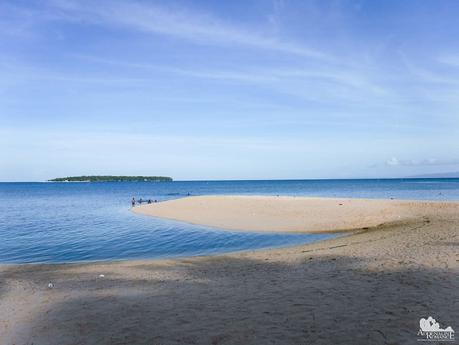
With a clear and blue summer sky, Digyo Island’s main sandbar basks in all its stunning glory. The cerulean seascape that meets the heavens forms a beautiful background for the rest of the islands in the Cuatro Islas group. Check the photo below; it isn’t difficult to understand why everybody falls to the charm of this island.
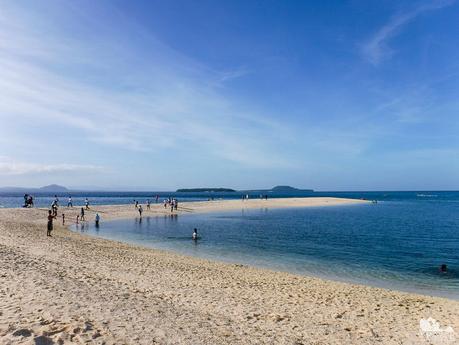
At the tip of the sandbar, we can see the entirety of Digyo Island. As you can see, it’s not a large island at all; it only has a land area of less than 5 hectares. But it’s definitely a pocket of tropical paradise.
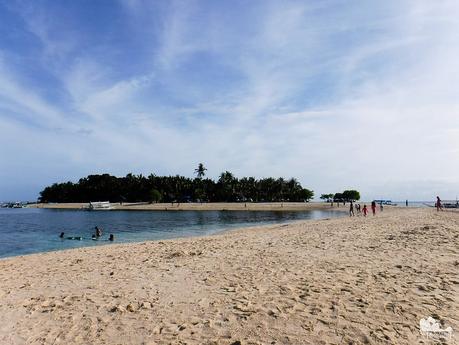
Our boatmen arrived more than an hour later than our scheduled departure time. When we asked them why they were late, they sheepishly admitted that they took another group of tourists to an island hopping tour; we wouldn’t be surprised if those tourists end up being disappointed.
Anyway, with us on board, the boat roared to life and departed away from Digyo Island, now brimming with cool colors thanks to a clear day and a blazing hot sun. We took a last look at the sandy paradise that turned out to be our savior and relief from a disappointing Cuatro Islas adventure.
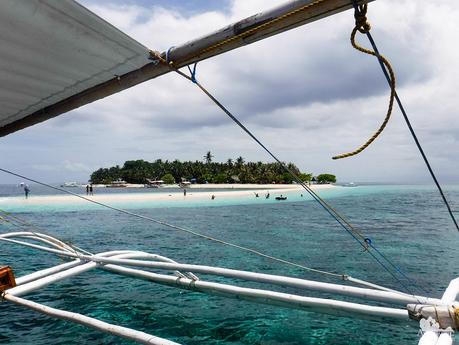
Special Thanks
We would give special thanks to the valiant and hardworking policemen who are stationed in Digyo Island. Not only did they keep an eye on our things and kept the island safe but they also helped us contact our boatmen when the latter did not arrive at the agreed time. Hats off to these helpful enforcers of the law.
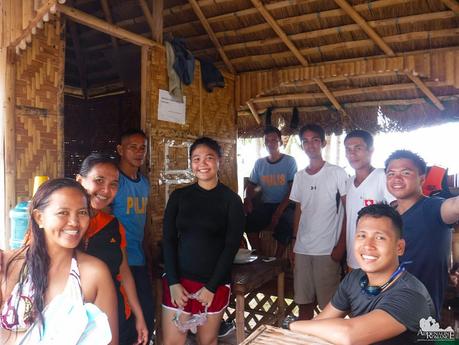
Contact Details
For more information, get in touch with the Inopacan Tourism Office at the following details:
- Website: Explore Inopacan Leyte
- Landline: 565-0200 / 565-0311
- Cellphones: 0918-346-3753 / 0910-364-9464 / 0926-803-1131
- PAMBI-Cuatro Islas Protected Landscape and Seascape – 0948-487-2500
Budget*
- P 275 per person – non-aircon bunk Cebu to Hilongos, Leyte via Roble Shipping Lines (same rate applies on the return trip)
- P 25 per person – terminal fee at Cebu port
- P 12 per person – terminal fee at Hilongos port
- P 40 per person – jeepney fare from Hilongos to Inopacan
- P 3,300 per boat – round trip boat fare for supposedly one day of island hopping
- P 300 per boat – “passing” fee at Himokilan Island (this is probably a scam)
- P 70 per person – DENR entrance fee and environmental fee
- P 50 per tent – camping space fee in Digyo Island (see below)
- P 550 per large fish – fresh and grilled fish
Other Pertinent Fees in Digyo Island
- P 30 per head – entrance fee
- P 500 per unit – close cottage rental
- P 300 per unit – open-air cottage rental
- P 200 per unit – portable tent rental (with 1 table and 4 chairs)
- P 150 per unit – camping tent rental
- P 50 per unit – table rental
- P 10 per unit – chair unit
- P 50 per tent – camping space
- P 1,000 per boat – docking fee for boats that are not registered in LGU Inopacan
*Rates can change without prior notice. Get in touch with the Inopacan Tourism Office for the latest updates.
Tips
1. Unless things improve, we recommend you skip the Cuatro Islas island hopping tour and book a trip directly to Digyo Island. We are assuming that you will be able to save money this way since you don’t have to pay for the island hopping tour. We have not tried this though, but you can ask the tourism office about this option when you register.
2. Take note that your payment is round trip. That means, if you have planned for an overnight stay in Digyo Island, your boatman is supposed to fetch you the next day at an agreed time. However, due to the unscrupulous nature of boatmen there, there is a chance that they will not honor the agreement.
We’re not saying this has happened; but in any place, such unfortunate event is possible. It pays to be vigilant in a strange place. Thus, we urge you to do the following before leaving Inopacan:
- Write down your boatman’s name, cellphone number, and the name of his vessel.
- Take a photograph of your boatman as well as his vessel and its serial number.
- Make sure that he takes note of the time you want to be fetched. Send a text message to him by the time you reach Digyo Island, and let him see that you sent him a message.
- Take the name and number of the tourism officers. We suggest you record three or four officers.
- Get the number of the local police. They can assist you if things go downhill.
- Get the name and number of another boatman for emergencies.
- Once you get to Digyo Island, have a policeman (there are policemen in Digyo Island) accompany you to your boat so he can take a good look at it. These law enforcers know these boats, the boatmen, and their owners. They can help you if you get stranded.
3. Whether you are going for a day tour or staying overnight in Digyo Island, we recommend you buy your food, drinks, and supplies in Inopacan town proper to save money. Prices of goods sold in Digyo Island are around twice or thrice more than in the mainland. Ideally, the only thing that you should buy in Digyo Island is a few gallons of fresh water for bathing and washing.
5. If you wish to camp like us, bring your own tent so you can save money. Besides, the tents for rent are ordinary beach tents in poor quality.
6. The island has a toilet and bath, but please save water because fresh water is a very scarce resource here. Do not use more than you should. We suggest you take a shower when you get back to the mainland.
7. Always keep an eye on your things. Being a public island, all kinds of people are there. We recommend putting your valuables in a good-quality waterproof dry bag so you can always carry it with you even when you’re swimming.
8. Pack light but bring the following:
- drinking water (at least five liters)
- sandals
- umbrella, hat, or sarong
- snacks and softdrinks
- packed food and/or ingredients for your main meals
- swimming attire
- goggles/mask and snorkel
- extra clothes
- extra money for emergencies
- personal toiletries and medication
9. Waterproof your clothes, gadgets, and other belongings by wrapping them in a plastic bag before putting them in your backpack.
10. Remember to Leave No Trace of your visit. Do not litter; place your garbage in a large bag to be taken back to the city for proper disposal. Do not take any rock, plant, sand, that belongs to the island.
11. Keep your sandals, flip-flops, or aqua shoes on to protect your feet from sharp rocks as well as broken glass and other debris that may be hidden under the sand.

